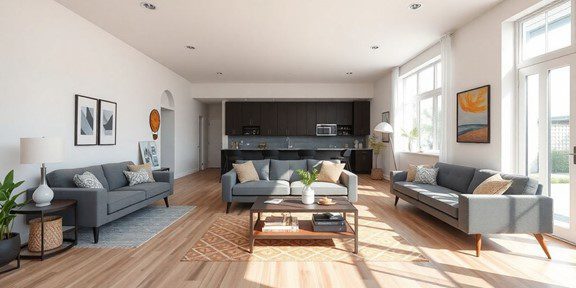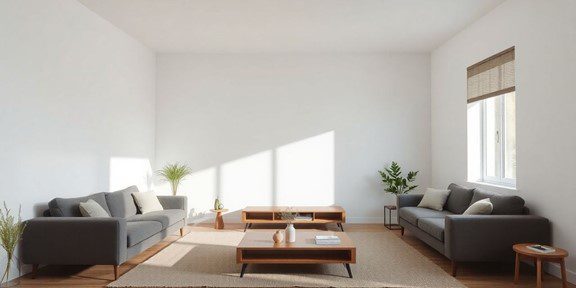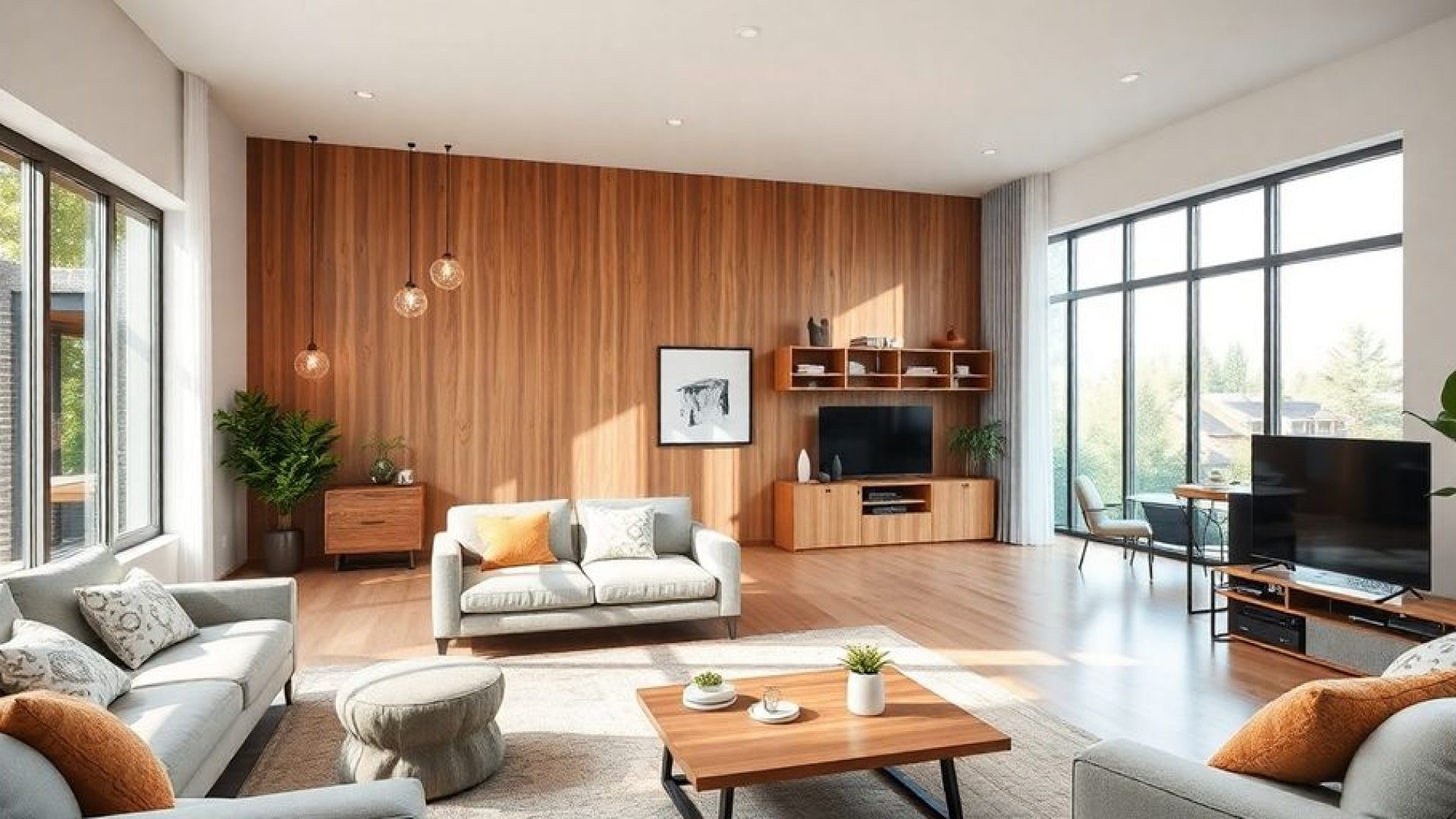In today’s world, our homes need to be more than just a place to live—they should adapt to our changing lifestyles. Flexible home design is all about creating spaces that can evolve with your needs, whether you’re welcoming a new family member, setting up a home office, or planning for retirement. In this article, we’ll explore practical ways to make your home a dynamic and versatile space that suits you now and in the future.
Key Takeaways
- Flexible home design allows spaces to adapt to various needs over time.
- Incorporating movable walls and modular furniture can create versatile living areas.
- Planning for future changes, like family growth or remote work, is essential in home design.
- Maximising outdoor spaces can enhance your living experience and connect you with nature.
- Smart home technology can improve functionality and energy efficiency, making life easier.
Understanding Flexible Home Design
Defining Flexible Design
So, what exactly is flexible home design? It’s all about creating a home that can adapt to your changing needs over time. Think of it as future-proofing your living space. It’s not just about aesthetics; it’s about functionality and how your home can evolve with you. This might mean adaptable floor plans that can be easily reconfigured, or designing rooms for multiple uses. It’s a core principle of modern home design WA, and something we at Tinee Homes take seriously.
Benefits of Flexibility in Homes
Why bother with all this flexibility stuff? Well, the benefits are pretty significant. For starters, it can save you money in the long run. Instead of moving to a bigger house when your family grows, you can simply reconfigure your existing space. It also promotes sustainability by reducing the need for constant renovations or new builds. Plus, flexible layouts for growing families can make your home a more enjoyable and functional space to live in, no matter what life throws your way. It’s about creating a space that supports your lifestyle, not the other way around.
Key Features of Flexible Home Design
Okay, so what does flexible home design actually look like in practise? Here are a few key features to consider:
- Multi-functional rooms: Designing rooms that can serve multiple purposes is crucial. A home office that can double as a guest room, for example.
- Movable walls and partitions: These allow you to easily reconfigure your space as needed.
- Modular furniture: Furniture that can be easily rearranged or repurposed is a great investment.
- Open-plan living: This creates a sense of spaciousness and allows for greater flexibility in how you use your space.
Flexible home design isn’t just a trend; it’s a smart way to approach homeownership. It’s about creating a space that can adapt to your changing needs and lifestyle, ensuring that your home remains a comfortable and functional place to live for years to come. At Tinee Homes design process explained, we focus on this concept to ensure your home is ready for anything.
Ultimately, how to future-proof your house design comes down to thinking ahead and planning for the unexpected. By incorporating these key features, you can create a home that is both stylish and adaptable.
Creating Convertible Spaces
Let’s face it, our homes need to work harder than ever. Gone are the days of rooms with just one purpose. We need spaces that can adapt to our ever-changing lives. This section explores how to design your home with flexibility in mind, creating areas that can easily transform to suit your needs.
Incorporating Movable Walls
Movable walls aren’t just for fancy offices anymore! They’re a fantastic way to create adaptable spaces in your home. Imagine being able to instantly divide a large living area into two smaller, more intimate spaces, or opening up a room for a party. Movable walls offer that flexibility. They come in various styles, from sliding panels to folding screens, so you can find one that suits your aesthetic and budget. Think about how you could use them to create a temporary guest room, a quiet workspace, or even just to change the feel of a room.
Utilising Modular Furniture
Modular furniture is your best friend when it comes to creating convertible spaces. Think sofas that can be reconfigured into different shapes, tables that can expand or collapse, and storage units that can be stacked or rearranged. The key is to choose pieces that are lightweight, easy to move, and serve multiple purposes. This allows you to quickly adapt your space to different activities, whether it’s a family movie night or a dinner party. Plus, modular furniture is often designed with storage in mind, helping you to keep clutter at bay.
Designing Multi-Functional Rooms
Why have a room that only serves one purpose when you can have one that does it all? Designing multi-use living spaces is all about thinking creatively about how you use your home. For example, a dining room could double as a home office, or a guest room could be used as a yoga studio when not occupied. The trick is to choose furniture and decor that can easily be adapted to different uses. Consider incorporating storage solutions that can hide away clutter, and using lighting to create different moods. Many people are converting spare rooms into home offices, so it’s a popular trend.
Think about how you actually live in your home. What activities do you do most often? What spaces do you wish you had? By answering these questions, you can start to design multi-functional rooms that truly meet your needs.
Here’s an example of how a room can be multi-functional:
|
Function |
Furniture/Features |
Notes |
|
Home Office |
Desk, ergonomic chair, shelving |
Ensure good lighting and comfortable seating. |
|
Guest Room |
Sofa bed, side table, lamp |
Choose a comfortable sofa bed and provide basic amenities for guests. |
|
Exercise Area |
Yoga mat, weights, mirror |
Ensure enough space for movement and consider adding a sound system. |
Planning for Future Lifestyle Changes

Adapting to Family Growth
Thinking about the future is super important when designing a tiny home. What works now might not work in five or ten years. If you’re planning on having kids, or if your family might grow in other ways, you need to factor that into your design. Can that spare room easily become a nursery? Is there space to add a small extension later on? These are the questions you need to ask yourself. It’s all about future-proofing your space so you don’t outgrow it too quickly. Consider how easily spaces can be re-purposed. A dining area might become a play area, or a study could transform into a bedroom. The key is to design with flexibility in mind.
Designing for Remote Work
More and more people are working from home these days, so having a dedicated workspace is a must. But in a tiny home, space is at a premium. Think about how you can create a functional and comfortable workspace without sacrificing too much living area. Maybe it’s a fold-down desk that can be tucked away when not in use, or a small nook that’s specifically designed for work. Good lighting and comfortable seating are also essential. Don’t forget about storage for all your work-related stuff! A well-designed home office can make all the difference to your productivity and well-being.
Preparing for Ageing in Place
It’s not something many of us like to think about, but planning for ageing in place is crucial, especially in a smaller home. This means designing your home so that it’s accessible and safe as you get older. Things like wider doorways, grab rails in the bathroom, and a no-step entry can make a big difference. Consider the layout and ensure that everything you need is easily reachable. Think about future mobility needs and how you might adapt the space if you need to use a wheelchair or walker. It’s about making your home a place where you can live comfortably and independently for many years to come.
Designing for the future isn’t just about adding extra space; it’s about creating a home that can adapt to your changing needs and lifestyle. It’s about thinking ahead and making smart choices that will pay off in the long run.
Maximising Outdoor Living Areas
Australians love the outdoors, so extending your living space beyond the four walls of your home is a no-brainer. It’s about creating a seamless transition where indoor comfort meets the beauty of nature. How can you make the most of your outdoor space? Let’s explore some ideas.
Extending Indoor Spaces Outdoors
Think of your outdoor area as another room in your house. The key is to create a smooth flow between inside and out. This can be achieved through:
- Large sliding doors or bi-fold doors that open up completely.
- Using similar flooring materials inside and outside to visually connect the spaces.
- Continuing the colour scheme from your interior design to your outdoor furniture and decor.
This approach blurs the lines and makes your home feel bigger and more connected to the surrounding environment. If you’re considering multifunctional furniture designs for inside, think about weather-resistant options for your outdoor area too.
Creating Inviting Patios and Decks
A well-designed patio or deck is the heart of any outdoor living area. Consider these elements:
- Comfortable seating: Invest in quality outdoor furniture that you’ll actually want to use. Think lounges, armchairs, and dining sets.
- Shade: Essential for those hot Aussie summers. Options include pergolas, awnings, umbrellas, or even strategically planted trees.
- Lighting: Create a warm and inviting atmosphere with outdoor lighting. String lights, lanterns, and spotlights can all work well.
Don’t forget the details! Outdoor rugs, cushions, and throws can add texture and personality to your space. A fire pit or outdoor heater can extend the use of your patio or deck into the cooler months.
Incorporating Nature into Design
Bring the beauty of nature right to your doorstep. Here’s how:
- Plants: Potted plants, hanging baskets, and vertical gardens can add greenery and life to your outdoor area.
- Water features: The sound of running water can be incredibly relaxing. Consider a small fountain or pond.
- Natural materials: Use materials like timber, stone, and bamboo in your outdoor furniture and landscaping to create a natural feel.
If you’re thinking about home extensions in Perth, consider how you can integrate your outdoor space into the overall design. It’s about creating a harmonious balance between your home and the natural world.
Innovative Storage Solutions
Living in a smaller space, like a tiny home, means getting creative with storage. It’s not just about having storage, it’s about making the most of every nook and cranny. Let’s look at some clever ways to keep your tiny home organised and clutter-free.
Custom Built-In Storage
Custom built-in storage is a game-changer for tiny homes. Forget generic shelves; think storage designed specifically for your space and needs. What are the benefits of custom built-in storage? Well, it could be under-bed drawers, hidden compartments in stairs, or even a pull-out pantry that fits perfectly into that awkward corner. The key is to maximise every inch available. This approach not only provides ample storage but also adds a touch of personality and character to your tiny home. It’s about creating a seamless blend of functionality and aesthetics.
Utilising Vertical Space
Don’t just look across, look up! Vertical space is your best friend in a tiny home. How can you use vertical space? Think tall, narrow shelves, wall-mounted cabinets, and hanging organisers. These solutions draw the eye upwards, making the space feel larger and more open. Plus, they keep things off the floor, reducing clutter and creating a more airy feel. Consider installing hooks for hanging pots and pans in the kitchen or using a ladder to access high shelves. It’s all about thinking vertically to maximise storage potential.
Hidden Storage Ideas
Who doesn’t love a good secret? Hidden storage is not only practical but also adds an element of surprise to your tiny home. Where can you hide storage? Consider these ideas:
- Under-floor storage: Perfect for stashing away seasonal items or things you don’t use often.
- Hollow furniture legs: A clever way to store small items like keys or remote controls.
- Mirror cabinets: Combine functionality and storage by installing cabinets behind mirrors in the bathroom or bedroom.
By incorporating these hidden storage solutions, you can keep your tiny home clutter-free and maintain a sense of order and calm. It’s about finding creative ways to conceal your belongings while keeping them easily accessible when needed.
Thinking about tiny home finance? Clever storage can help you decide what you really need to bring with you.
Integrating Smart Home Technology
Smart home tech can really lift the functionality of a tiny home. It’s not just about fancy gadgets; it’s about making the most of your limited space and resources. Let’s look at how you can integrate smart tech into your tiny home.
Enhancing Functionality with Tech
Smart tech can transform how you use your tiny home. Think about it: lights that adjust automatically, a thermostat you can control from your phone, and security systems that keep you safe, even when you’re away. It’s about making life easier and more efficient. How can you use technology to make your tiny home more functional? Well, here are a few ideas:
- Smart lighting systems can be programmed to adjust brightness and colour temperature throughout the day, mimicking natural light and saving energy.
- Voice-activated assistants like Google Home or Amazon Echo can control various devices, from lights and thermostats to entertainment systems.
- Smart security systems with cameras and motion sensors can provide peace of mind, especially if you travel frequently.
Energy Efficiency through Smart Devices
Energy efficiency is a big deal in tiny homes. Smart devices can help you reduce your environmental footprint and save money on bills. Smart thermostats, for example, learn your habits and adjust the temperature accordingly. Smart plugs can turn off devices that are drawing power when not in use. It all adds up.
By monitoring your energy usage with smart metres, you can identify areas where you’re wasting power and make adjustments. This not only helps the environment but also puts more money back in your pocket.
Convenience and Control
Ultimately, smart home tech is about convenience and control. Imagine being able to turn on the lights or adjust the temperature before you even get home. Or getting an alert if there’s a water leak while you’re away. It’s about having the power to manage your home from anywhere. You can even integrate smart home automation to control your blinds.
Here are some ways to boost convenience:
- Remote control of appliances: Turn on your kettle or oven from your phone.
- Automated routines: Set up routines for waking up, going to bed, or leaving the house.
- Real-time monitoring: Keep an eye on your home’s temperature, humidity, and air quality from anywhere.
Embracing Minimalism in Design

Minimalism isn’t just a trend; it’s a philosophy that aligns perfectly with the tiny home lifestyle. It’s about intentionally living with less, focusing on what truly adds value to your life, and creating a space that feels calm and uncluttered. But how do you actually achieve that minimalist aesthetic in your tiny home?
Prioritising Essential Items
Start by taking stock of everything you own. Ask yourself: Do I use this regularly? Does it bring me joy? If the answer to both is no, it might be time to let it go. This isn’t about deprivation; it’s about being intentional with your possessions. Think quality over quantity. Instead of having ten cheap t-shirts, invest in a few well-made ones that will last. Consider the ‘one-in-one-out’ rule: for every new item you bring into your home, get rid of something else. This helps prevent clutter from accumulating.
Creating a Calm and Orderly Space
A minimalist space is a calm space. Clutter can be visually overwhelming and contribute to stress. Find a place for everything, and make sure everything is in its place. Use storage solutions to keep items out of sight when not in use. Choose a neutral colour palette for your walls and furniture to create a sense of serenity. Natural light is your friend – maximise it with sheer curtains or blinds that let the light in while maintaining privacy. Avoid excessive decorations or knick-knacks. Remember, less is more.
The Aesthetic of Minimalism
Minimalism isn’t just about getting rid of stuff; it’s also about creating a visually appealing space. Choose furniture with clean lines and simple designs. Opt for natural materials like wood, linen, and cotton. Consider incorporating the Japanese concept of wabi-sabi, which celebrates imperfection and simplicity. This can mean embracing the natural grain of wood or the slightly uneven texture of handmade ceramics. It’s about finding beauty in the imperfect and authentic.
Minimalism is about more than just decluttering; it’s about creating a life that is intentional, meaningful, and aligned with your values. It’s about freeing yourself from the burden of excess and focusing on what truly matters.
Here’s a few ideas to get you started:
- Declutter regularly: Set aside time each week or month to go through your belongings and get rid of anything you no longer need or use.
- Invest in multi-functional items: Choose furniture and appliances that serve multiple purposes to save space and reduce clutter.
- Embrace digital minimalism: Reduce your reliance on physical items by using digital alternatives whenever possible, such as e-books, streaming services, and online banking.
By embracing minimalism, you can create a tiny home that is not only functional and efficient but also a sanctuary of calm and simplicity. You can also simplify your lifestyle by reducing the amount of items you own.
Minimalism in design is all about keeping things simple and clean. It helps create spaces that feel open and calm. By focusing on what really matters, you can make your designs more effective and enjoyable. If you want to learn more about how to embrace minimalism in your own projects, visit our website for tips and inspiration!
Final Thoughts on Flexible Home Design
In wrapping up, designing a home that can adapt to your changing needs is really important. Flexibility in your space means you can make it work for you, whether you’re working from home, welcoming guests, or planning for a growing family. Simple ideas like movable walls or convertible furniture can make a big difference. At Tinee Homes, we’re all about creating spaces that fit your lifestyle now and in the future. If you’re keen to explore how we can help you design a home that’s just right for you, don’t hesitate to get in touch. We’re here to help you create a living space that’s not just a house, but a home that grows with you.
Frequently Asked Questions
What is flexible home design?
Flexible home design means creating spaces that can change based on your needs. It allows you to use rooms for different purposes over time.
What are the benefits of having a flexible home?
Having a flexible home can save you money and space. It helps you adapt your living area as your family grows or your lifestyle changes.
How can I create convertible spaces in my home?
You can create convertible spaces by using movable walls, modular furniture, and designing rooms that can serve multiple functions.
How do I plan for future lifestyle changes in my home design?
Think about how your life might change in the future, like having kids or working from home. Design spaces that can easily adapt to these changes.
What are some ways to enhance outdoor living areas?
You can extend your indoor spaces outdoors by adding decks or patios. Use outdoor furniture and plants to make these areas inviting.
How can I incorporate smart home technology into my design?
Smart home technology includes devices like smart thermostats and lighting systems. These can make your home more efficient and easier to control.

